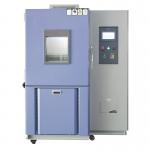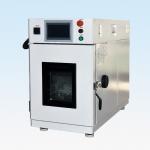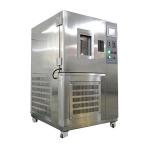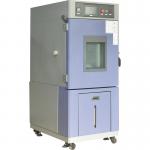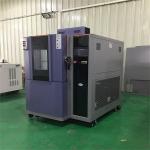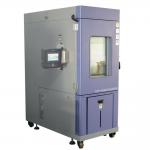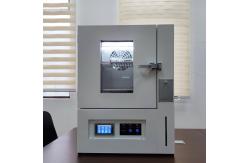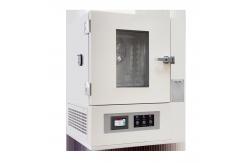In the fast-paced and highly competitive electronics industry, the
reliability and durability of electronic components are of
paramount importance. The Customized Benchtop High Low Temperature
Environmental Test Chamber for the Electronics Industry has emerged
as a crucial instrument for manufacturers and researchers alike,
enabling them to unlock the secrets of how these components perform
under extreme temperature conditions. This specialized benchtop chamber is meticulously designed to
create and maintain a precisely controlled environment of high and
low temperatures. Its primary purpose is to subject electronic
components, such as semiconductors, circuit boards, connectors, and
sensors, to a wide range of thermal stress. By replicating the
harshest temperature conditions that these components may encounter
during their lifecycle, from the freezing cold of arctic
applications to the scorching heat of industrial machinery or
desert environments, manufacturers can evaluate their performance,
identify potential weaknesses, and optimize their designs. This not
only ensures the quality and reliability of the final electronic
products but also helps in complying with industry standards and
regulations. - Compact and Durable Design
- The chamber is constructed with a space-efficient yet robust
design, making it an ideal fit for laboratory benchtops. The
exterior is typically made of high-quality, corrosion-resistant
steel or rigid polymers, providing excellent protection against
physical damage and ensuring long-term durability. The interior is
lined with a non-reactive and smooth surface, such as stainless
steel or a specialized non-conductive material, to prevent any
interaction between the chamber and the tested electronic
components. Despite its compact size, the chamber is equipped with
top-notch insulation. This insulation minimizes heat transfer,
allowing for accurate temperature control and reducing energy
consumption. The door of the chamber is engineered for a tight seal
and easy operation. It features a reliable locking mechanism and a
heavy-duty gasket that can withstand the pressure differentials
caused by rapid temperature changes. The door also includes a clear
viewing window, usually made of tempered glass with anti-fog and
anti-scratch properties, enabling users to monitor the testing
process without disturbing the internal environment.
- Precision Temperature Control Systems
- Temperature Range: The chamber can achieve an extensive temperature
range, typically from -60°C to +180°C. This wide spectrum allows
for testing under both cryogenic and extremely hot conditions,
which is essential for evaluating the performance of electronic
components in diverse applications. The temperature control system
is highly accurate, with an accuracy of ±0.2°C. It utilizes
advanced refrigeration and heating technologies, along with a
sophisticated feedback loop and multiple temperature sensors
strategically placed within the chamber. This ensures uniform
temperature distribution and rapid temperature change capabilities,
enabling efficient thermal cycling experiments and accurate
evaluation of component performance.
- Programmability: The control panel of the chamber is highly
programmable, allowing users to create and store complex
temperature profiles. This means it can simulate cyclic temperature
changes, stepwise temperature gradients, or any custom temperature
sequence. For example, it can mimic the temperature fluctuations
that a smartphone component might experience during its normal
operation or during a stress test. The control panel is
user-friendly and intuitive, with a clear display that shows the
current temperature, the set temperature profile, and the status of
the testing process.
- Advanced Instrumentation and Data Acquisition
- The chamber is outfitted with a comprehensive suite of sensors.
Temperature sensors are distributed evenly to detect any
temperature gradients and ensure a homogeneous thermal environment.
These sensors are connected to a state-of-the-art data acquisition
system that records and stores all the measured data. The data can
be accessed and analyzed in real-time or retrieved later for
in-depth studies. The data acquisition system is highly flexible
and can be integrated with external software and databases,
facilitating seamless data transfer and analysis. It can also be
configured to send notifications and reports automatically, saving
time and effort for the users. Additionally, the control panel
includes built-in alarms and safety features that alert users in
case of any abnormal conditions, such as temperature excursions
outside the set limits, power failures, or equipment malfunctions.
- Volume and Dimensions: The benchtop design offers a relatively small but efficient
testing volume, usually ranging from a few liters to around 30
liters. The interior dimensions are carefully optimized to ensure
that electronic components are exposed to consistent temperature
conditions. The external dimensions are compact enough to fit on a
standard laboratory benchtop, typically with a width of around 30
to 50 centimeters, a depth of 30 to 50 centimeters, and a height of
40 to 70 centimeters.
- Temperature Uniformity: The temperature uniformity within the chamber is maintained
within ±0.3°C. This ensures that all parts of the tested electronic
components experience a similar thermal environment, which is
crucial for obtaining accurate and reliable test results. Even a
slight temperature difference across a component can lead to
different performance outcomes, especially in sensitive
applications such as microelectronics.
- Temperature Stability: The stability of the temperature is excellent, with minimal
fluctuations over time. This allows for long-term testing and the
evaluation of a component's performance under stable temperature
conditions, as well as its ability to withstand temperature changes
over extended periods. The chamber is designed to maintain a
constant temperature within a very narrow range, ensuring the
reproducibility of test results.
- Accurate Simulation of Extreme Temperatures
- The primary function of this chamber is to provide a highly
accurate and realistic simulation of specific high and low
temperature conditions. By precisely controlling the temperature,
it allows manufacturers to evaluate how electronic components will
behave in various real-world situations. For example, in the
automotive electronics industry, it can test the performance of
engine control unit components under extreme heat, ensuring they
function properly even in high-temperature engine compartments. In
the aerospace electronics sector, it can assess the reliability of
satellite components under the extreme cold of space and the heat
generated during re-entry.
- The ability to create complex temperature profiles, such as cyclic
temperature changes, is also a valuable function. This can help in
identifying potential weaknesses or failure points in components
that may not be apparent under static temperature conditions. For
instance, a component that is exposed to daily temperature cycles
may experience stress-induced damage over time, and this chamber
can accurately replicate such scenarios to determine the durability
and reliability of the component.
- Enhanced Product Quality and Reliability
- Through comprehensive testing in the chamber, manufacturers can
identify and address potential issues in their electronic
components. If a component shows signs of degradation or failure
under specific temperature conditions, appropriate measures can be
taken, such as modifying the design, changing the material
composition, or improving the manufacturing process. This leads to
the development of more stable and reliable electronic products,
reducing the risk of field failures and product recalls. It also
helps in optimizing product warranties and service intervals, as
manufacturers have a better understanding of the component's
durability under different temperature stressors.
- The test chamber also serves as a powerful tool for research and
development. It allows engineers and scientists to study the
effects of temperature on new electronic materials and component
designs. For example, in the field of semiconductor research, the
chamber can be used to investigate the behavior of new materials
under different temperature conditions, leading to the discovery of
new semiconductor properties and the development of more efficient
electronic devices.
- Compliance with Industry Standards and Regulations
- The electronics industry is highly regulated, and many standards
and regulations require testing of components in specific
temperature conditions. The Customized Benchtop High Low
Temperature Environmental Test Chamber is a reliable tool for
ensuring compliance. For example, components used in military and
aerospace electronics must meet strict thermal shock resistance
requirements. By using this chamber to conduct tests in accordance
with relevant standards, manufacturers can prove that their
components meet the necessary criteria, facilitating market access
and building trust with customers and regulatory bodies. Regulatory
bodies rely on accurate test results obtained from such chambers to
enforce safety and quality regulations.
|
